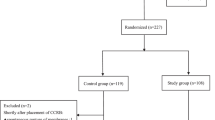Abstract
Purpose
The present study was aimed to compare the effects of the use of electroacupuncture and misoprostol in inducing labor in patients with Bishop score < 7 and to observe the characteristics of labor in both methods.
Methods
As much as 67 pregnant women with Bishop score < 7, single cephalic presentation with gestational age confirmed by first-trimester ultrasound, reactive cardiotocography, and amniotic fluid volume and estimated fetal weight within the respective normal ranges for gestational age were selected. They were randomized into 2 groups: electroacupuncture (AC) or misoprostol (M).
Results
There were no significant differences regarding age, gestational age, fetal weight, parity, Bishop score, or indication for induction. Labor was the main outcome, which was obtained in both groups without significant difference regarding frequency (p = 0.07) and time of induction (p = 0.29). Absence of obstetric complication, higher duration of labor (p = 0.036), and tendency to a higher satisfaction of the patients (p = 0.046) were observed among patients of group AC. Higher frequency of cesarean sections (p = 0.014) and obstetric complications (9.3%) were observed among patients of group M.
Conclusions
Our results showed that electroacupuncture can be used to obtain cervical ripening, with similar results as compared with misoprostol, with a significantly higher frequency of vaginal deliveries and without occurrence of obstetric complications.


Similar content being viewed by others
References
Maul H, Mackay L, Garfield RE (2006) Cervical ripening: biochemical, molecular and clinical considerations. Clin Obstet Gynecol 49:551
Nice Guidance (2008) CG70 Induction of labour. http://www.nice.org.uk/guidance/index.jasp?action=byID&o=12012
The American College of Obstetricians and Gynecologists ACOG (2009) Pratice Bulletin Number 107. Obstet Gynecol 114(2 Pt 1):386–397. doi:10.1097/AOG.0b013e3181b48ef5
Mozurkewich E, Chilimigras J, Koepke E, Keeton K, King VJ (2009) Indications induction of labour. A best-evidence review. BJOG doi:10.1111/j.1471-0528.2008.02065.x
Zeisler H, Tempfer C, Mayerhofer K, Barrada M, Husslein P (1998) Influence of acupuncture on duration of labor. Gynecol Obstet Invest 46(1):22–25
Skilnand E, Fossen D, Heiberg E (2002) Acupuncture in the management of pain in labour. Acta Obstet Gynecol Scand 81:943–948
Ernst E, White AR (2001) Prospective studies of the safety of acupuncture. A systematic review. Am J Med 110(6):481–485
Carlsson CPO, Axemo P, Bodin A, Carstensen H, Ehrenroth B, Madegård-Lind I, Navander C (2000) Manual acupuncture reduces hyperemesis gravidarum. A placebo-controlled, randomized, single-blind, crossover study. J Pain Symptom Manage 20:273
Forrester M (2003) Low back pain in pregnancy. Acupunct Med 21(1–2):36–41
WHO (1996) Care in normal birth. A practical guide. WHO, Geneva
Smith CA, Crowther CA (2004) Acupuncture for induction of labor. Cochrane Database Syst Rev (1):CD002962
Rabl M, Ahner R, Bitschnau M, Zeisler H, Husslein P (2001) Acupuncture for cervical ripening and induction of labor at term—a randomized controlled trial. Wien Klin Wochenschr 113(23–24):942–946
Selmer-Olsen T, Lydersen S, Mørvked S (2007) Does acupuncture used in nulliparous women reduce time from prelabour rupture of membranes at term to active phase of labour? A randomized controlled trial. Acta Obstet Gynecol Scand 86:1447–1452
Tremeau ML, Fontanie-Ravier P, Teurnier F, Demouzon J (1992) Protocol for cervical maturation by acupuncture [Protcole de maturation cervical par acupuncture]. J Gynecol Obstet Biol Reprod (Paris) 21:375–380
Zeisler H, Rabl M, Joura EA, Husslein P (2000) Prenatal acupuncture and serum prostaglandin-E2 levels during the first stage of labor. Geburtsh Frauenheilk 60:638–640
Tsuei JT, Lay Y, Sharma SD (1977) The influence of acupuncture stimulation during pregnancy: the induction and inhibition of labor. Obstet Gynecol 50:479–488
Tsuei JT, Lai YF (1974) Induction of labor by acupuncture and electric stimulation. Obstet Gynecol 43(3):337–342
Yip S, Pang J, Sung M (1976) Induction of labor by acupuncture electro-stimulation. Am J Chin Med 4(3):257–265
Smith CA, Cochrane S (2009) Does acupuncture have a place as an adjunct treatment during pregnancy? A review of randomized controlled trials and systematic reviews. Birth 36(3):246–253
Lundeberg T, Lund I, Sing A, Näslund A (2009) Is placebo acupuncture what it intends to be? eCAM. Evid Based Complement Alternat Med [Epub ahead of print]
Jiaying L, Ying H, Ning Z, Bing W, Yu Z, Deli Y, Guirong Z, Ying W, Junfeng P (2008) The safety of electroacupuncture at Hegu (LI4) plus oxytocin for hastening uterine contraction of puerperants-A randomized controlled clinical observation. J Tradit Chin Med 28(3):163–167
Sanchez-Ramos L, Kaunitz AM, Wears RL, Delke I, Gaudier FL (1997) Misoprostol for cervical ripening and labor induction: a meta-analysis. Obstet Gynecol 89(4):633–642
Allais G, Ciochetto D, Airola G, Schiapparelli P, Bosio A, Benedetto C (2003) L’agopuntura nella gestione del travagliodi parto. [Acupuncture in labor management.] (In Italian with English abstract). Minerva Ginecol 55:503–510
Acknowledgments
The author thank to all the staff of the outpatient clinic of the Maternidade Escola, Federal University of Rio de Janeiro who referred the patients to the study, the physicians who followed the patients, and the ultrasonographists who participated in their selection. The authors acknowledge Dr Paulo Boschcov, for his revision of the final version of the manuscript.
Conflict of interest statement
None.
Author information
Authors and Affiliations
Corresponding author
Rights and permissions
About this article
Cite this article
Gribel, G.P.C., Coca-Velarde, L.G. & Moreira de Sá, R.A. Electroacupuncture for cervical ripening prior to labor induction: a randomized clinical trial. Arch Gynecol Obstet 283, 1233–1238 (2011). https://doi.org/10.1007/s00404-010-1526-x
Received:
Accepted:
Published:
Issue Date:
DOI: https://doi.org/10.1007/s00404-010-1526-x




